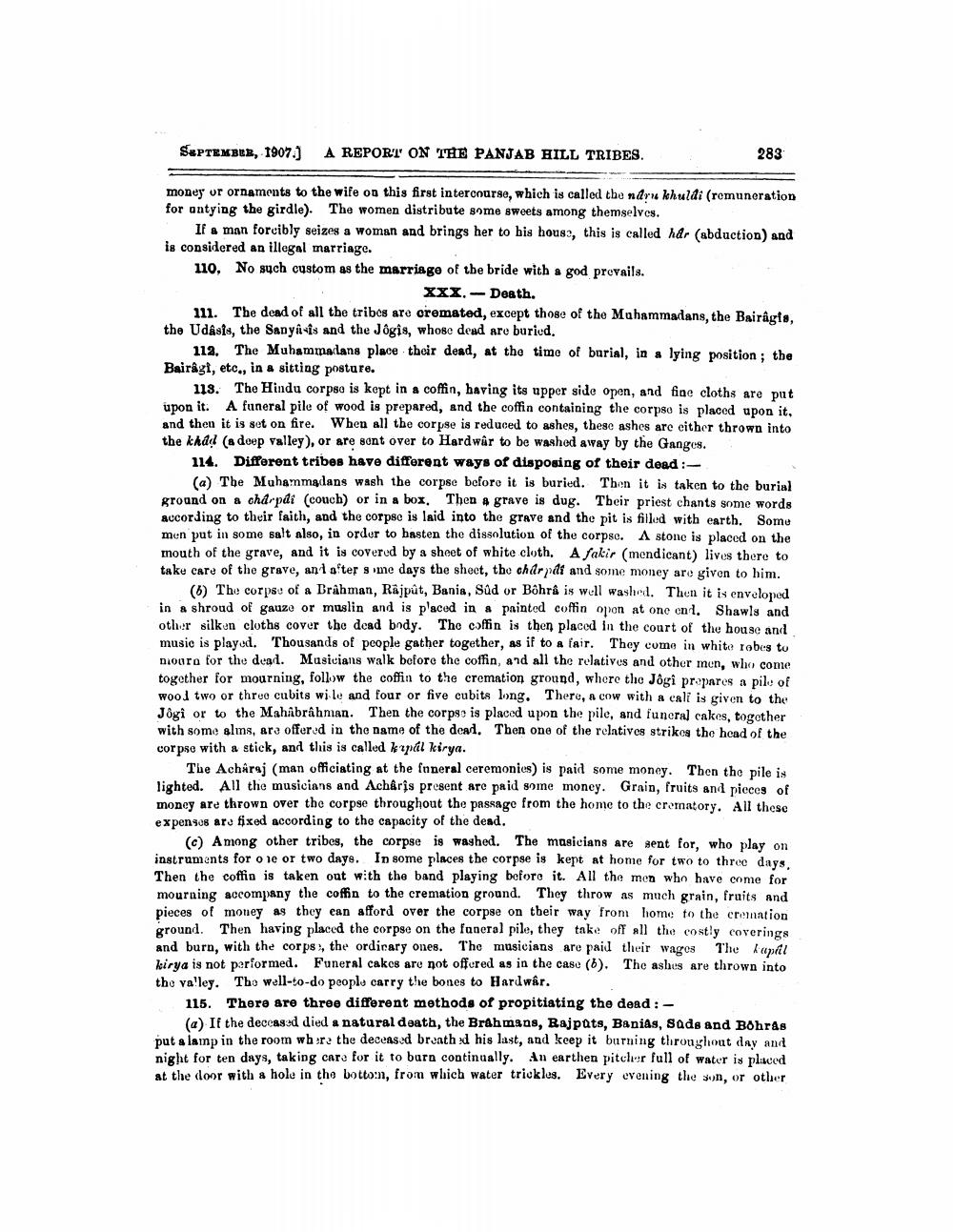________________
SEPTEMBER, 1907.)
A REPORT ON THE PANJAB HILL TRIBES.
283
money or ornaments to the wife on this first intercourse, which is called the ndrue khuldi (remuneration for ontying the girdle). The women distribute some sweets among themselves.
If a man forcibly seizes a woman and brings her to bis houss, this is called Mar (abduction) and is considered an illegal marriage. 110, No such custom as the marriage of the bride with a god provails.
xxx. - Death. 111. The dead of all the tribes are cremated, except those of the Muhammadans, the Bairagis, the UdAsis, the Sanyasis and the Jôgis, whose dead are buried.
112. The Muhammadans place their dead, at the time of burial, in a lying position; the Bairagt, etc., in a sitting posture.
113. The Hindu corpse is kept in a coffin, having its upper side open, and fine cloths are put upon it. A funeral pile of wood is prepared, and the coffin containing the corpse is placed upon it, and then it is sot on fire. When all the corpse is reduced to ashes, these ashes are either thrown into the khayl (a doep valley), or are sent over to Hardwâr to be washed away by the Ganges.
14. Different tribes have different ways of disposing of their dead :
(a) The Muhammalans wash the corpse before it is buried. Then it is taken to the burial ground on a charpdi (couch) or in a box. Then a grave is dug. Their priest chants some words according to their faith, and the corpse is laid into the grave and the pit is filled with earth. Somu mun put in some salt also, in order to basten the dissolution of the corpsc. A stone is placed on the mouth of the grave, and it is covered by a sheet of white cloth. A fakir (mendicant) lives there to taku care of the grave, and after s ime days the shect, the charpdi and some money are given to him.
(6) The corpse of a Brahman, Rajput, Bania, Süd or Bôhrá is well washed. Then it is enveloped in a shroud of gauzo or muslin and is placed in a painted coffin opon at one end. Shawls and other silkin cloths cover the dead body. The coffin is then placed in the court of the house and music is played. Thousands of people gather together, as if to a fair. They come in white robes tu moara for the deal. Musicians walk before the coffin, and all the relatives and other men, who come together for mourning, follow the coffin to the cremation ground, where the Jogi prapares a pil, of wool two or three cubits wile and four or five cubits long. There, a cow with a cali is given to the Jogi or to the Mahabrahman. Then the corpse is placed upon the pile, and funeral cakes, together with some alms, ars offered in the name of the deal. Then one of the relatives strikes the head of the corpse with a stick, and this is called kapal kirya.
The Achâraj (man officiating at the funeral ceremonies) is paid some money. Then the pile is lighted. All the musicians and Achåris present are paid some money. Grain, fruits and pieces of money are thrown over the corpse throughout the passage from the home to the crematory. All these expen9o8 ars fixed according to the capacity of the dead.
(6) Among other tribes, the corpse is washed. The masicians are sent for, who play on instruments for one or two days. In some places the corpse is kept at home for two to three days. Then the coffin is taken out with the band playing before it. All the men who have come for mourning accompany the coffin to the cremation ground. They throw as much grain, fruits and pieces of money as they can afford over the corpse on their way from home to the cremation ground. Then having placed the corpse on the faneral pile, they take off all the costly coverings and burn, with the corps, the ordiсary ones. The musicians are paid their wages The kupil kirya is not performed. Funeral cakes are not offered as in the case (6). The ashes are thrown into the valloy. The well-to-do people carry the bones to Hardwâr.
115. There are three different methods of propitiating the dead :
(a) If the deceased died a natural death, the Brahmans, Rajputs, Banias, sade and Bohras put a lamp in the room wbre the deceased brunth d his last, and keep it burning throughout day and night for ten days, taking care for it to burn continually. An earthen pitchur full of water is plisced at the door with a hole in the botton, from which water trickles. Every evening the sun, or other




